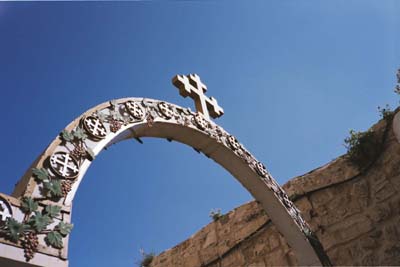JERUSALEM - Saleh Abualteen is in the rent-a-cross business. For over 30 years, the 55-year-old Israeli-Arab Muslim has rented large, olive-wood crosses to Christian pilgrims who carry them on their shoulders and retrace the final footsteps of Jesus Christ, along the Via Dolorosa. The Via Dolorosa is a narrow, stone path believed to be the route Jesus took to His Crucifixion nearly 2000 years ago. It is also known as "The Way of The Cross" or "The Way of Sorrow" and is one of Christendom's most sacred sites. Each year thousands of Christian pilgrims visit and walk along this path. It is here that Christians relive and celebrate Christ's Passion, Death and Resurrection. The Via Dolorosa is filled with religion and ritual. But over the years, this sacred and spiritual path has sprouted into a corridor of organic commercialism. Souvenir stores and their savvy salesmen flog crass, religious trinkets. A portrait of Jesus Christ adorned with a twinkling, neon-green crown of torns is on sale for 40 shekels - or $10. A sweet deal for sacrilege. In comparison, Abualteen's rent-a-cross trade seems like one of the more discreet forms of cashing in on Christian devotion. There is no flamboyant salesmanship in Abualteen's trade. No "step right up and rent a cross," talk.
Abualteen stashes his holy merchandise in a small 5-by-5 foot room, located opposite the 5th station of the cross. "I don't want a shop-front for my business," says Abualteen. "My crosses have been broken and desecrated before. Some people even spit on them when I've kept them downstairs, along the Via Dolorosa. That's why I hide them up here now," he says, peaking into a dusty room filled with 35 crosses, perched 10 feet above street-level. There are 14 stations of the cross along the Via Dolorosa; nine along the street and five inside the Church of the Holy Sepulchre, where the faithful believe Christ was buried. Each site marks a significant event along Christ's journey to his crucifixion on Good Friday. Most stations have a chapel or church for meditation and prayer. Christian pilgrims and tour operators usually pay Abualteen $30 to 40 dollars to rent a cross. And the payment is not necessarily a straight transaction. Abualteen says he usually charges for a Polaroid photo he snaps of the pilgrims carrying the cross. Each cross can weigh anywhere from 15 to 40 kilos. "The Poles and the Germans like the heavier crosses," says Abualteen, "while the French and the Italians take the lighter ones." For many, the cross-carrying concept looks like a hard-core-Christian experience. But the Rev. Angelo Eson, a Fransciscan monk at the Church of the Holy Sepulchre, frowns upon the practice. "This it not deep devotion, this is deep commercialism" says 50-year-old Father Eson "I would never rent a cross and carry it in this fashion." But Eson's disapproval is not sending Abualteen out of business. The Intifada is. During the peak pilgrim period - from the start of Lent in March to Easter Sunday in April - Abualteen usually rents up to 15 to 20 crosses a day. But in these times of Intifada it's an amazing grace if he rents one or two. "Even during the Gulf War business was not so bad like this," he laments. "No Christians, no pilgrims, no cross rentals for me." The effects are felt all over the Holy Land. "It is a disaster this year," says Zoabi Razi, the owner of Nazareen Travel in Nazareth. "Ninety-nine per cent of our trips have been cancelled," says Zoabi, who now runs 15 tour buses. He was running 150 during the same period last year. Tour leaders have come to expect cancellations. Rick Townend, the 38-year-old principal of the Archbishop Denis O'Connor Catholic High School in Ontario, Canada, sits at the Church of the Holy Sepulchre. Townend is on his fourth journey to the Holy Land. On each trip he's brought 28 to 30 Catholic educators here. This year there are only nine in his group. "Many dropped out of the trip at the last minute." said Townend. "And those of us who came felt first hand what this conflict is really about." Jerusalem is a city is divided physically by walls and spiritually by religion and nationalism. Its holy alleys remain filled with friars, faith and religious friction. Along the Villa Dolorosa, rosaries sway on religious hips. While rifles wrap around the shoulders of relentless Israeli soldiers. Security is particularly tight every Friday afternoon when a procession of brown- robbed Franciscan Friars lead the way along the station of the cross, from where Christ was condemned by Pontius Pilot to Calvary, where he was crucified. Four to five policemen flank the pious procession. The service is conducted in English, Latin, Italian and Arabic. Father Eson leads the prayer in English. The first station of the cross is the former headquarters of the Roman garrison, and now the Al Omariya school. The procession shuffles to the second station of the cross, where Esons' voice and his Christian prayers struggle to rise above the sound of the Muslim call to prayer from the nearby Al-Aksa Mosque. "We try to delay starting the procession in order to miss the 1500 call to prayer, says Eson. "But inevitably our prayer services collides." In the Old City, both religions give praise at the same critical time of day. Religious voices struggle for air-time. And while the voices may rise, the religious tensions remain earth bound. Just a few hundred yards away from the Via Dolorosa, Jews pray at the Western Wall. Above the wall, Muslim attend the Al Aksa Mosque. It comes to a literal and metaphoric intersection of the world's three monotheistic faiths. Here, within these sacred walls, Jews, Muslims and Christians alike celebrate their rituals and religious rites, in search of eternal redemption. But what they may never find is a respite from the religious tensions, so closely riddled to Israel's political strife. |
